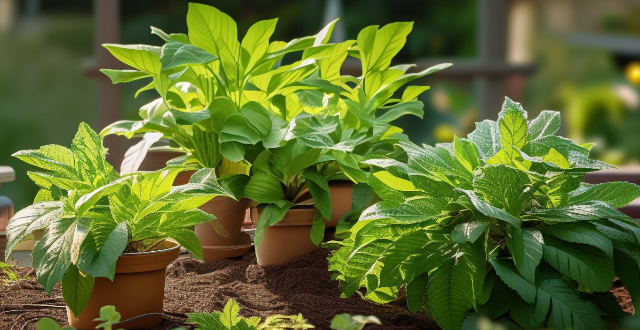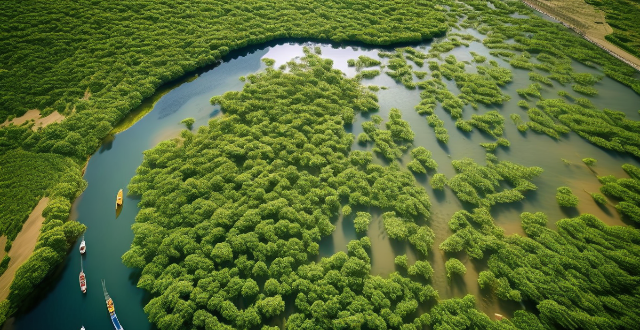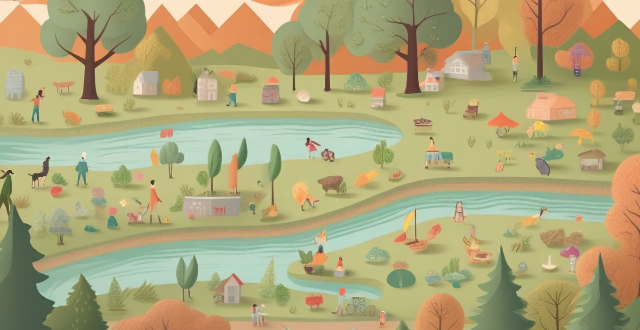Species Plant

Can climate change cause extinction of certain species ?
Climate change has the potential to cause the extinction of certain species through a variety of mechanisms including rising temperatures, changes in precipitation patterns, loss of habitat, and disruption of food webs. It is essential that we take action to mitigate the effects of climate change and protect vulnerable species before it's too late.

How do invasive species interact with climate change to threaten native biodiversity ?
Invasive species and climate change pose significant threats to native biodiversity by exacerbating range expansion, altering competition, increasing predation pressure, degrading habitats, facilitating disease transmission, disrupting mutualisms, having synergistic effects, depleting resources, displacing keystone species, and reducing ecosystem resilience. Integrated management strategies are crucial for mitigating these threats and include habitat restoration, invasive species control, protection of keystone species, and conservation of diverse genetic pools within native species to enhance their adaptability.

How can I revive a dying indoor plant ?
Reviving a dying indoor plant requires patience, care, and attention to detail. Here are some steps you can take to help your plant recover: Identify the problem, adjust watering schedule, provide adequate sunlight, fertilize appropriately, prune dead leaves and stems, repot if needed, monitor for pests and diseases, maintain humidity levels. By following these steps and providing regular care and attention, you can revive a dying indoor plant and help it thrive once again.

How does biodiversity affect ecosystem services ?
Biodiversity plays a vital role in ecosystem services, including provisioning (like food and water), regulating (climate and flood control), cultural (recreational and spiritual enrichment), and supporting services (soil formation and nutrient cycling). Diverse plant species ensure resilience against pests and diseases, reducing the need for chemical interventions. Wetlands with varied vegetation types can more effectively filter pollutants from water than those with limited plant diversity. Different plant species play roles in carbon sequestration through photosynthesis, leading to more efficient carbon uptake and storage. Biodiversity can help regulate diseases by reducing the likelihood of pathogen spread. Diverse environments like coral reefs or tropical rainforests offer richer experiences for activities such as diving, hiking, and birdwatching. A variety of organisms, including bacteria, fungi, and earthworms, contribute to soil formation and maintenance, which is essential for plant growth. Different species have specialized roles in the cycling of nutrients. High biodiversity means functions can be performed by multiple species, providing a safety net if one species fails. Conservation efforts aimed at protecting and restoring biodiversity are vital for the sustained health of our planet's ecosystems.

How is global warming impacting biodiversity and endangered species ?
Global warming is impacting biodiversity and endangered species through habitat loss, changes in weather patterns, and increased disease outbreaks. Habitat loss occurs as species are forced to migrate due to rising temperatures, leading to competition for resources and loss of habitats. Changes in weather patterns cause extreme events like droughts, floods, and storms, disrupting ecosystems and potentially leading to species extinction. Additionally, global warming contributes to the spread of diseases among wildlife populations, posing a threat to endangered species. It is crucial to take action to mitigate the effects of global warming and protect vulnerable populations.

Why are the leaves of my indoor plant turning yellow ?
Yellowing leaves on indoor plants can indicate various issues, including improper watering, nutrient imbalances, unsuitable lighting, temperature stress, pest infestations, diseases, physical damage, or natural aging. Addressing these concerns involves adjusting watering habits, providing adequate light, using appropriate fertilizers, maintaining ideal temperatures, monitoring for pests and diseases, handling plants gently, and regular pruning. Understanding and responding to these factors can help restore the plant's health and prevent future leaf discoloration.

How do invasive species affect biodiversity ?
Invasive species can have a significant impact on native biodiversity, both positively and negatively. They can outcompete and replace native species, leading to changes in community structure and ecosystem function. Invasive species can also cause damage to infrastructure and human health through the spread of disease or destruction of habitats. Management strategies for invasive species include prevention measures such as quarantines and biosecurity protocols, as well as control measures such as eradication programs and habitat restoration. It is important to consider the costs and benefits of each strategy when developing a management plan.

What is the ideal temperature for indoor plant growth ?
Indoor plants generally thrive in temperatures between 65°F to 75°F during the day and slightly cooler at night, along with proper humidity and air circulation. Maintaining these conditions helps promote healthy growth and flowering. Use a thermometer, avoid drafts, and adjust heating or cooling as needed to keep plants comfortable.

How might climate change influence the distribution and abundance of aquatic species ?
Climate change significantly impacts the distribution and abundance of aquatic species by altering water temperature, pH levels, salinity, and oxygen availability. These changes affect habitats and life cycles of aquatic organisms, causing direct and indirect effects on their survival, growth, reproduction, and community interactions. Some species show resilience through genetic adaptation or phenotypic plasticity. Proactive conservation efforts are crucial for maintaining biodiversity and ecosystem health amid climate shifts.

What are the impacts of global warming on ecosystems and species diversity ?
Global warming, primarily caused by human activities, significantly impacts ecosystems and species diversity. These effects include habitat loss, altered species interactions, the spread of invasive species, disease proliferation, ocean acidification, melting permafrost, changes in fire regimes, water stress, sea level rise, coral bleaching, increased extinction risk, shifting ranges, population declines, adaptation challenges, loss of genetic diversity, behavioral changes, phenological shifts, reproductive challenges, physiological stress, and disrupted mutualisms. Addressing these issues requires immediate action to reduce greenhouse gas emissions and adapt to the changing climate.

How should we prioritize the protection of endangered species and ecosystems ?
The protection of endangered species and ecosystems is a critical issue that requires immediate attention. Here are some strategies we can employ to prioritize their protection: 1. Conduct comprehensive surveys and studies to identify and understand the current state of endangered species and ecosystems. 2. Develop effective legislation and policies, such as establishing protected areas, regulating hunting and fishing, and promoting sustainable development. 3. Raise public awareness and involvement through education programs, community involvement, and media campaigns. 4. Collaborate internationally by signing international agreements, sharing knowledge and resources, and coordinating conservation efforts. By taking these steps, we can work towards ensuring the survival of our planet's diverse flora and fauna for future generations.

What is the relationship between climate change and loss of habitat for endangered species ?
Climate change is causing significant changes in ecosystems around the world, leading to the loss of habitat for endangered species. Rising temperatures, changing precipitation patterns, sea level rise, and extreme weather events are all factors that contribute to this loss. Endangered species are particularly vulnerable to these changes due to their small populations and limited ranges. Examples of endangered species affected by climate change include polar bears, giant pandas, leatherback turtles, and amphibians. It is essential that we take action to protect these species and their habitats, including reducing greenhouse gas emissions, conserving natural habitats, and developing adaptation strategies.

How can I incorporate more plant-based meals into my family's diet ?
Incorporating more plant-based meals into your family's diet can lead to improved health, weight management, and a reduced environmental impact. Here's how to do it: 1. **Understand the Benefits**: Improved health, weight management, and environmental sustainability are key advantages of a plant-based diet. 2. **Gradual Transition**: Start by replacing one or two meals per week with plant-based options to ease your family into the change. 3. **Meal Ideas**: Try Meatless Mondays, vegetable-centric dinners, and incorporating plant-based proteins like tofu and beans. 4. **Involve Your Family**: Get your family excited about the change by letting them choose recipes and shop for ingredients. 5. **Shopping Tips**: Buy fresh produce, stock up on staples like grains and legumes, and experiment with new foods. 6. **Education and Resources**: Use online resources like websites, YouTube channels, and cookbooks to learn about plant-based eating. 7. **Meal Planning and Preparation**: Plan weekly meals, consider batch cooking, and get creative with leftovers. 8. **Emphasize Flavor and Creativity**: Use herbs, spices, marinades, and sauces to add flavor, and don't be afraid to experiment with different cooking techniques.

How much sunlight do indoor plants need ?
Indoor plants require sunlight for photosynthesis, but the amount needed varies by species. General guidelines include low light tolerance for plants like Peace Lily and Snake Plant, medium light requirements for Dracaena and Pothos, and high light preference for Cacti and Succulents. Key considerations involve window orientation and artificial lighting. Success tips include researching plant needs, monitoring response, and gradual adjustment to new lighting conditions.

How does climate vulnerability affect the environment ?
Climate vulnerability refers to the degree to which a system is susceptible to, and unable to cope with, adverse effects of climate change. This vulnerability can have profound impacts on the environment, affecting ecosystems, biodiversity, and the services they provide to humans. Key points include changes in ecosystems, loss of biodiversity, impacts on water resources, food security, and coastal systems. These changes can lead to altered migration patterns, changes in vegetation, disruption of life cycles, habitat loss, extreme weather events, invasive species, changes in snowmelt patterns, rainfall changes, shifting climate zones, pest and disease outbreaks, sea level rise, and ocean acidification. Addressing climate change is essential for the survival of countless species and the well-being of human societies that depend on the services provided by healthy ecosystems.

What is the relationship between biodiversity and ecosystem services ?
The text discusses the relationship between biodiversity and ecosystem services, emphasizing that biodiversity is crucial for maintaining the health and functionality of ecosystems. It highlights that diverse species contribute to ecological processes, and many ecosystem services rely on specific species or groups. High biodiversity can lead to more resilient ecosystems, while its loss can diminish these services. The text suggests that conservation efforts can enhance both biodiversity and ecosystem services, underlining the importance of recognizing and protecting this relationship for human well-being.

What are the potential long-term effects of global warming on ecosystems ?
Global warming, caused by greenhouse gases, can have severe impacts on ecosystems worldwide. Potential long-term effects include species extinction, changes in distribution and abundance of species, alteration of ecosystem functions, loss of habitat due to rising sea levels, and invasion of non-native species. These impacts underscore the need for action to mitigate climate change and protect ecosystems.

What is the impact of climate change on biodiversity and conservation law ?
Climate change is a significant threat to biodiversity, affecting species distribution, abundance, and behavior. This has implications for conservation law, which aims to protect and manage biodiversity. The impact of climate change on biodiversity includes habitat loss and fragmentation, altered ecosystem functioning, and increased risk of species extinction. Conservation law must evolve to address these challenges, incorporating resilience measures into conservation strategies and fostering collaboration across sectors. By taking a proactive approach, we can help ensure that future generations continue to benefit from the diverse array of species and ecosystems that make up our planet's natural heritage.

How does climate change affect migration patterns ?
Climate change has significant impacts on migration patterns, affecting routes, timing, and even causing species displacement. Traditional migration pathways become unviable due to rising temperatures and shifting habitats. Altered seasonality disrupts the synchrony between migration events and ecological processes like plant blooming or insect emergence. In extreme cases, species may be forced out of their native ranges entirely. Mitigating strategies include habitat protection, climate change mitigation efforts, adaptation strategies, research and monitoring, and public awareness campaigns.

Is it necessary to mist indoor plants regularly ?
Is misting indoor plants necessary? Misting can increase humidity and cleanliness, but also lead to over-watering, pests, and disease. It's beneficial for tropical plants and during dry seasons, but not always necessary. Use warm water, avoid direct sunlight, target leaves, and don't overdo it.

What are the best indoor plants for low-light conditions ?
The best indoor plants for low-light conditions include Pothos, Snake Plant, Philodendron, Peace Lily, and ZZ Plant. These plants are adaptable, easy to care for, and known for their ability to purify the air. They come in various sizes and shapes, making them suitable for different preferences and spaces.

What are the consequences of climate change for wildlife and ecosystems ?
Climate change has significant consequences for wildlife and ecosystems, including habitat loss, changes in species distribution, impacts on biodiversity, altered ecological processes, invasive species spread, pest outbreaks, and human health risks. It is crucial to take action to mitigate these impacts by reducing greenhouse gas emissions and implementing conservation measures.

What are the benefits of a plant-based diet for women ?
A plant-based diet offers numerous health benefits for women, including improved cardiovascular health, weight management, cancer prevention, bone health, reproductive health, digestive health, skin health, and mental wellbeing. It is important to consult with a healthcare professional or registered dietitian when making significant dietary changes.

What are the impacts of climate change on tree species diversity in forests ?
Climate change significantly impacts tree species diversity in forests through altered growth and reproduction patterns, range shifts, disturbance regimes, direct physiological effects, and changes in ecosystem services. These impacts not only affect the health and structure of forests but also have broader ecological and societal implications.

What are some strategies for eating a more plant-based diet ?
Strategies for eating a more plant-based diet include embracing whole foods, experimenting with alternative proteins, getting creative with meal planning, learning about nutritional balance, educating yourself, supporting sustainable practices, and connecting with others. These steps can help you transition to a healthier and environmentally friendly way of eating while ensuring you receive all the necessary nutrients.